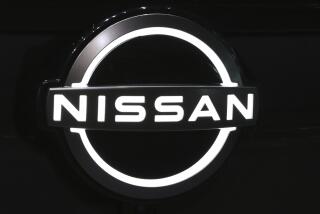PRACTICAL VIEW : Don’t Count on Air Bags to Catch You Every Time
- Share via
Air bags have become popular safety equipment on new automobiles, but will they perform correctly--and up to consumer expectations--when needed?
Safety advocates, including the Insurance Institute for Highway Safety, insist that air bags work 99% of the time, even after years without maintenance.
Edwin Grossman thinks otherwise.
Grossman, a San Diego County resident, claims the air bags on his 1991 Acura Legend LS Coupe failed to deploy in a major frontal collision last year. Honda, which makes the Acura, denies that the system malfunctioned.
The dispute illustrates the difference in expectations that auto makers and consumers have about air-bag protection. The industry generally gives little information in owners’ manuals or elsewhere about when air bags are supposed to deploy, says Brian O’Neill, president of the Insurance Institute.
Grossman says he was driving down a private road at 35 m.p.h. in December when he collided head-on with a postal vehicle. The two air bags in his Acura failed to deploy, and his seat belt stretched enough that his head hit the steering wheel, he says.
“I was out for about 10 seconds, and when I came to, blood was gushing out of my nose like it was coming out of a faucet,” recalls Grossman, who owns a mobile home park in Fallbrook. Although shaken up, he wasn’t seriously injured.
The Acura sustained $6,000 in damage, including a bent frame, according to Quality Faith Auto Body, which repaired the car. The garage verified that the air bag did not deploy.
Honda representatives inspected the car and determined that the air bag was operating correctly, Honda spokesman Mike Spenser says. He says the force of the impact was insufficient to trigger the air bag, because: the collision occurred at an angle, not head-on; the postal vehicle was lighter than the Acura, and the accident occurred on a dirt road, where cars tend to skid more freely than on pavement, reducing the amount of energy the car absorbs in the collision. He also says speed was a factor.
Air bags are generally designed to deploy when a car hits a fixed barrier head-on at speeds of 12 m.p.h. or more. But collisions seldom occur at a perfect head-on angle, and cars are not fixed barriers. The Safety Institute’s O’Neill said most complaints about air bags come from accident victims who report that their air bags failed to deploy. But investigation shows that the crashes generally were not violent enough to warrant deployment.
Nonetheless, O’Neill added, “under ideal circumstances, any time a belted occupant’s face hits the steering wheel, we hope that the bag deploys. Certainly, that is the design concept of the air bag.”
Grossman asked Honda to repurchase his car. The firm offered to buy back the car for $1,000 less than wholesale Blue Book, but Grossman declined.
“I could get litigious, but what for? I don’t need the money,” he says. “I have no confidence in the car any more. I am going to buy an American car.”
The Insurance Institute claims air bags save hundreds of lives. A study released last year by the group found that driver deaths were cut by 29% in frontal crashes in air-bag-equipped cars.
But, O’Neill warns, “people should not think they are a cure-all. I think there is an education job still needed.”







